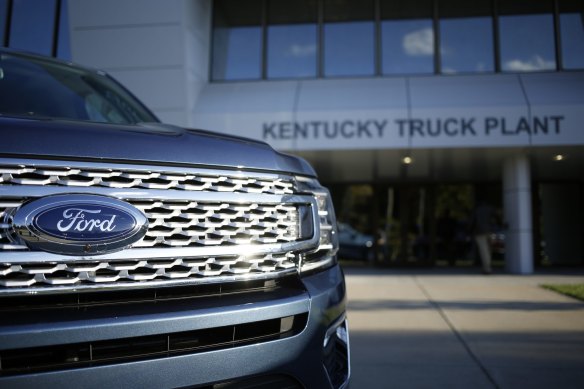Trump’s green attack threatens the future of the US car industry
Trump seems to be driven, as the title of the orders suggests, by his commitment to increasing US oil and gas production despite US oil output running at record levels under Biden. Reduced demand for petrol if the EV transition were to continue would conflict with his “drill, baby, drill” aspiration of even more production and lower petrol prices.
The unintended consequences of withdrawing the incentives for EV purchases and investment in new EV plants and battery factories could, however, be severe.
Fuelled by those incentives within the IRA, more than $US130 billion has been invested or committed to new battery factories – with more in the pipeline – and tens of billions of dollars have been invested in EV plants in the biggest splurge of investment in the sector in decades.

Ford – one of America’s oldest companies – is among the major auto producers pivoting its business towards electric vehicles.Credit: Bloomberg
Ford, GM, Toyota, Stellantis, Honda, BMW and others have all invested heavily in EV-related capacity, and there has been a similar boom in the rest of the supply chain for EVs, including the critical minerals needed for batteries.
The range of incentives to purchase or make EVs and their batteries is designed to make the pricing of EVs competitive with internal combustion-driven vehicles while the EV sector scales up and also to counter the subsidies and other forms of government support EV manufacturers receive in other jurisdictions and in China in particular.
Loading
Those massive investments would be stranded if Trump removes the US incentives; EV take-up in the US would slow; US auto companies efforts to catch up with the Chinese, Europeans and Japanese in EV and battery technologies would be handicapped and, with the rest of the world steadily moving towards an EV future, the role of the US companies within the global industry would be steadily diminished, and relegated to producing anachronistic vehicles for a domestic market.
While the take-up of EVs and hybrids in the US has been slower than in other major markets, and the major manufacturers have been losing money on their EV sales, the commitment of companies like Ford and GM to continuing to invest in EV and EV batteries production signals their view of the industry’s future.
It’s not just the IRA that Trump wants to gut.
America’s “tailpipe” rules, restored by Biden after Trump abolished them in his last term, set limits on exhaust emissions while increasing fuel economy requirements. The regulations, from model year 2027, become more stringent through to 2032, with auto companies able to comply by selling a mix of internal combustion cars, hybrids, EVs or hydrogen-power vehicles.
The US Environmental Protection Agency has forecast that by 2032, about 56 per cent of new passenger vehicles sold will be electric and another 16 per cent hybrids. That would bring the US industry closer to the point at which mass EV production could be economic.
Trump’s antipathy towards EVs and the climate-related measures Biden introduced through the Inflation Reduction Act will, if he can implement it, be a major blow to the US industry’s ability to create a viable industry, one competitive with the Chinese companies leading the EV sector that is steadily displacing internal combustion vehicles.
European, Japanese and South Korean carmakers and their policymakers are committed to electric – or at least hybrid as a transitional technology – futures.
Another, perhaps even bigger blow – because it would also impact their still-dominant conventional vehicle production – would be if Trump follows through on Tuesday’s threat to impose a 25 per cent tariff on imports from Mexico and Canada from February 1.
Ford, GM, Toyota, Stellantis, Honda, BMW and others have all invested heavily in EV-related capacity and there has been a similar boom in the rest of the supply chain for EVs, including the critical minerals needed for batteries.
Supposedly, that’s because of their role in facilitating illegal immigration to the US and fentanyl imports, although Canada is hardly a major participant in either of the bases for Trump’s claims.
The US auto industry is highly integrated with the auto industries and their supply chains in both those countries, Mexico’s in particular. In the manufacturing of a completed vehicle, components can criss-cross the southern US border several times before final assembly – and could be subjected to several 25 per cent duty imposts.
Loading
In the long run, the US companies could repatriate or reshore their cross-border industry, but that would be at a considerable cost to them and to US consumers. In the shorter term, if the tariffs are imposed, US consumers will bear most of the cost of the tariffs.
It is unclear whether Trump understands that his policies would not just kill off US auto companies’ EV activity in the US but also their historical dominance of the global industry, a position now under severe threat from the growth and technological sophistication of Chinese manufacturers and China’s control of the supply chains for EVs.
The Business Briefing newsletter delivers major stories, exclusive coverage and expert opinion. Sign up to get it every weekday morning.

